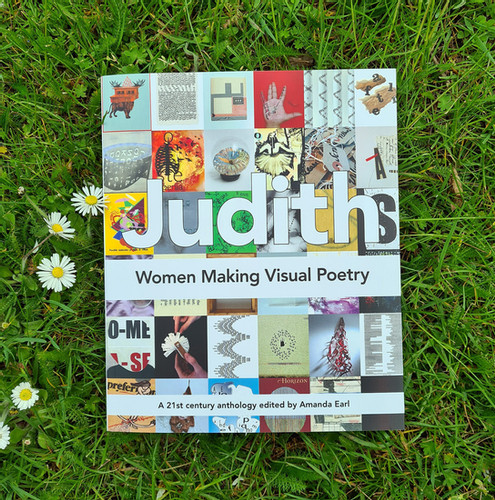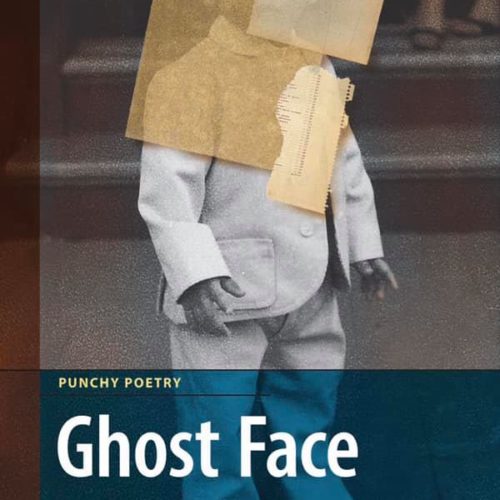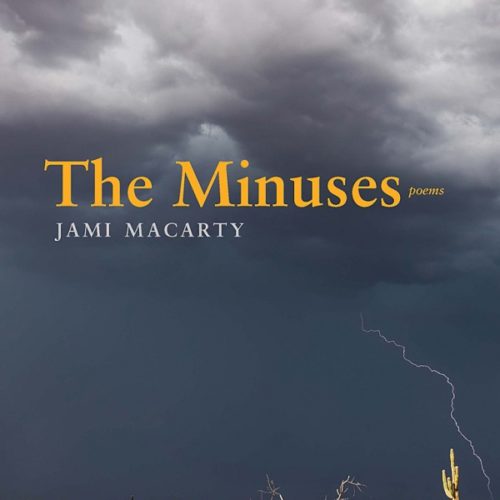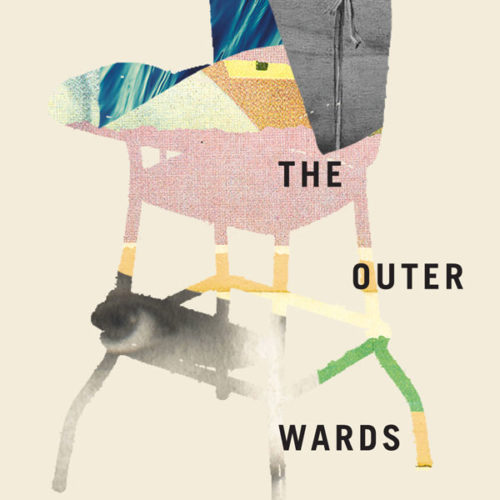The challenge of reception remains. How to make such work – by women in particular – visible within the general clutter of literary publishing and the larger field of cultural noise. But as gender politics in publishing meets the fertile graphical-poetic imagination of so many talented and engaging writers, these issues will resolve themselves. The terms ‘visual’ or ‘concrete’ seem less and less necessary as identifiers that separate one category of works from the larger field. All works of written poetry are graphical, but only some take advantage of that in interesting ways. The wonder is that such a varied and prolific outpouring is taking place – and being given the kind of notice signalled by this anthology. For someone of my generation, whose work was systematically denigrated, or, alternately, merely ignored, this is an excellent development to witness. Perhaps it will also serve to remind women of what is at stake in being in control of our own language – since that is where the political efficacy of our subjectivity resides. The politics of gender are not diminished in these days, only transformed, and the polymorphous approach to authority is intimately bound to questions of self-determination. If I cannot speak myself in terms appropriate to the symbolic presentation of my being, then how am I to act with the full warrant of citizenship in the linguistic world? The question can only be answered across the broad spectrum of gendered positions, beyond binarisms and oppositions, but also, cannot ignore the legacies structured into our language and the visual presentation of our selves. – Johanna Drucker, “(In)Visible Women or Gender in Concrete”

It would be hard not to be amazed by Ottawa poet, editor, critic and publisher Amanda Earl’s incredibly expansive, inclusive and long-awaited anthology Judith: Women Making Visual Poetry (Malmö, Sweden: Timglaset Editions, 2021), a book funded, in part, through an impressive crowdfunding campaign earlier this spring. Subtitled “A 21st century anthology,” Judith is named for Vancouver poet Judith Copithorne, who is known as the first woman in Canada to engage (in a sustained, ongoing way) with visual and concrete poetry, appearing in such important early Canadian concrete/visual poetry anthologies as the four author Four Parts Sand (Ottawa ON: Oberon Press, 1972), John Robert Colombo’s New Directions in Canadian Poetry (Toronto ON: Holt, Rinehart and Winston, 1971), bpNichol’s The Cosmic Chef (Ottawa ON: Oberon Press, 1970) and bill bissett’s THE LAST BLEWOINTMENT ANTHOLOGY VOLUME 1 (Toronto ON: Nightwood Editions, 1985), as well as in more recent volumes such as The Last Vispo Anthology: Visual Poetry 1998-2008 (Fantagraphics, 2012) and The New Concrete, Visual Poetry in the 21st Century (Hayward Gallery Publishing, 2015). For years now, Ottawa writer/publisher/bookseller jwcurry has been referring to Copithorne as “our first lady of concrete,” and Copithorne has actively been producing and publishing since the late 1950s. Earl’s acknowledgment of Copithorne is wonderfully appropriate, although it is curious to note that the first volume of concrete and visual works produced in Canada was actually Lozenges: Poems in the Shapes of Things (London ON: Alphabet Press, 1965) by poet Colleen Thibaudeau (1925-2012), a title that appeared mere months prior to the first publications by bpNichol himself, who spent an entire career working, among other forms, concrete and visual poetry. In the context of Thibaudeau’s own work, her experimentation with visual forms through Lozenges, published by her husband, the poet James Reaney, appears to have been an outlier; a line of experimentation set aside for her eventual and lengthy career focusing on more narrative forms of poetry.
Judith includes a foreword by Johanna Drucker, “(In)Visible Women or Gender in Concrete,” and introduction by Earl, “This Book Is an Action,” and the two trace the reasonings and arguments for examining these kinds of works, and theories for why so much of this has been historically overlooked. As Earl writes: “Over the years, I have been told numerous times by male publishers, editors, and visual poets that few women make visual poetry. And judging from visual poetry anthologies published in the twenty-first century, this appears to be true, with representation of women between 12-21% except for Women in Concrete Poetry and Poesia Visiva both of which publish works from the twentieth century.” As a response to that repeated assertion, Earl offers a comprehensive list of “1181 Women Making Visual Poetry” (a list that has grown since to more than 1200 names in her ongoing Google doc). The list of so many historical and practicing artists simply add to the heft and very essence of this collection: how could so many artists be overlooked, and for so long? As Earl introduces the list of names:
Beginning in April, 2019, Joakim Norling and I began to record the names of women making visual poetry in a shared spreadsheet in order to select potential contributors for the anthology. We easily reached 100 names and began inviting contributors to the book by the summer. The list kept growing. I asked for more names from our contributors and through social media. This list is the work of a community, many communities, with a shared goal to increase the visibility of women making visual poetry. we received names from editors, publishers and visual poets. Our list expanded to include Arabic calligraphers, Native American Ledger artists, quilters, word painters, photographers, sculptors and more. I found even more women sharing their visual poetry in the form of embroidered texts, collages, wearable art. We have included only the names here, but many of the women listed are easy to find on Google.
At the core of the collection sits works by a selection of artists from around the world working in visual and concrete forms: Rosaire Appel (USA), Viviane Rombaldi Seppey (Switzerland/USA), Kimberly Campanello (USA/Ireland/UK), Iris Colomb (London, UK), Amanda Earl (Canada), Judith Copithorne (Canada), Cinzia Farina (Enna, Italy), Ankie van Dijk (Netherlands), Satu Kaikkonen (Finland), Mara Patricia Hernandez (Mexico/USA), Dona Mayoora (aka Don May and Donmay Donamayoora, USA), Terri Witek (USA), Astra Papachristodoulou (UK), Karenjit Sandhu (UK), Mado Reznik (Argentina), Lenora de Barros (São Paulo, Brazil), Petra Schulze-Wollgast (pws) (Rostock, Germany), Ruth Wolf-Rehfeldt (Germany), Kate Siklosi (Tkaronto/Dish with One Spoon Territory/Toronto, Canada), Ines Seidel (Munich, Germany), Hiromi Suzuki (Japan), Erica Baum (USA) and Audra Wolowiec (New York, USA). The large format, as well as so many stunning, full-colour images give the collection the physical sense of a coffee table book, and each author’s section includes artist’s statements, a note on another artist that influenced their work, and a recent discovery, all of which provide context and further information on these artists and their works. As part of such, it is interesting to see the cross-influence between contributors: Kate Siklosi offers Ines Seidel’s work, for example, as her influence, and Astra Papachristodoulou as her discovery. As Siklosi writes on Seidel:
Ines Seidel’s work further instills in me a poethics of care, and of finding strength in fragility, that carries me through my poetic practice and beyond. In her work, she painstakingly sews paper and other materials together into wonderfully intricate sculptures – and in this delicate practice, she has taught me the creative value of patience and of ‘staying with the trouble’ while creating work that commands such acute attentiveness and care. This care-ful mindset toward the work has also been an incredibly sustaining ethos for me personally – and throughout 2020, it has been a critical tool for me in terms of working through and responding to the complexities of the world. Her work also informs my object work in terms of illuminating the constructed fabric of our reality, and the powerful and necessary role of creative intervention in that fabric to showcase both the resilience, transience, and beauty inherent in our being.
One of the elements interesting through this list, and this anthology, is the way in which Earl has really provided an expansion of the term “concrete and visual poetry” to include such forms as “embroidered texts, collages, wearable art” and multiple other ways in which artists explore text, a number of which were long dismissed, I might suspect, as merely being “women’s work” and not as any serious, sustained form. There are examples of more traditional considerations of visual and asemic writings in the collection, but Viviane Rombaldi Seppey, for example, works three-dimensional pieces with source materials including maps and phonebooks, and Kate Siklosi works with images of print on leaves and bark. Astra Papachristodoulou works with three-dimensional pieces, and her works in the collection include a puzzle, test tubes and candles. Her statement reads: “My work explores the confluence of poetry and art through a range of diverse sculptures that hopefully outgrow their minimalist bounds. I mainly use ecologically friendly materials such as bio-resin, beeswax and wood to respond to the urgent ecological challenges we face today. My object poems often have an interactive element and present alternate ways for poetry that is not fixed to the page. Extrapolating from my work is a set of techniques and values characterized by the layering of meanings and materials.” Through Judith, Earl’s sense of concrete and visual opens wide to include elements that had already appeared on the periphery of a peripheral form, now set in an accumulated centre of an expanded form that connects not only to literary writing but to larger and multiple considerations of conceptual art (I suspect a fraction of this comes from the fact that the publisher was open to including works, including photographs, in full colour). This collection not only expands the conversation of concrete and visual works, but connects those conversations to multiple other conversations already in-progress. As London, England-based contributor, Iris Colomb, writes for her included statement:
I am interested in the materiality of language and the ways in which text can exist both visually and performatively. Most of my projects involve building different relationships between these two states and exploring possibilities beyond linear written and spoken text. My visual poems are usually the starting points or the results of performances; they either function as performance scores or as the alternative spatial outcomes of time-based works. I enjoy producing textual objects that allow poems to adopt independent and changing structures. Their delivery is often affected by aleatoric or material elements developing through a physical engagement with the text as a three-dimensional thing to be manipulated. The material and visual elements of these objects create a space for additional layers of meaning, which cannot be dissociated from their linguistic content. When a performative piece becomes the starting point for a visual poem the process involves both a form of translation between media and a second state of poetic composition. My projects can therefore be led to take on multiple forms, both visual and performative. This aspect resonates strongly with both my conceptual and aesthetic concerns.
Adding even further to the heft of this collection, Judith concludes with a handful of essays: “A World of Signs: Women of Asemic Writing” by Natalie Ferris, “Handle with Care: A Study in (Poetic) Fragility” by Kate Siklosi, “Interview: The Thread Between Craft and Language” by Amanda Earl, and “Light and Code: Digital Ecologies of Poetic Form” by Fiona Becket. Judith explores far more than the ways in which individual artists have chosen to work, but the real nuts and bolts of literary creation in a wide range of possibilities, from sewing leaves and gallery space to digital creation. Judith explores creation, and the shifts within the form and the ways in which form opens, in ways not traditionally approached by male writers. This really is a remarkable collection, and deserves to remain in print for as long as possible. As Ferris offers as part of her essay:
However, for women the gestural, indecipherable or encoded offered not only the opportunity to challenge language’s monopoly on expression, but to challenge the patriarchy’s monopoly on meaning. Throughout history and across cultures and continents, women developed writing systems for their own use; often excluded from educational regimes designed for men, women turned to expressive registers to devise their own, individual or collection, and often secret, means of communication.
This collection is masterfully put together, both in form and in concept, and even includes, at the very end, an “In Memoriam,” a list “to honour and remember women visual poets and artists who died in the 21st century.” What is lovely about this collection is the sheer expansiveness of it, allowing anyone interested in the form further information on the potential handful of names they might already be aware of, as well as a series of worthy introductions to an incredible array of artists, providing a spring-board for an incredible amount of potential further study, research and creation. The approach to this collection is reminiscent of the ways in which Canadian women were working to carve out a space for a different kind of writing, in terms of content, form and possibility, throughout the 1960s and 70s. One could point to writers such as Daphne Marlatt, Nicole Brossard and Betsy Warland, and publishers such as Women’s Press, Ragweed Press and Room of One’s Own (since evolved into Room magazine), although one wonders why it took so long for visual poetry by women to be acknowledged. Perhaps it couldn’t happen until someone as driven and articulate as Amanda Earl to come along and finally put it together.
– rob mclennan
This essay was originally published on rob mclennan’s blog where you can find more of his writing.
Born in Ottawa, Canada’s glorious capital city, rob mclennan currently lives in Ottawa, where he is home full-time with the two wee girls he shares with Christine McNair. The author of more than thirty trade books of poetry, fiction and non-fiction, his most recent poetry titles include A halt, which is empty (Mansfield Press, 2019), Life sentence, (Spuyten Duyvil, 2019) and the book of smaller (University of Calgary Press, 2022). In spring 2020, he won “best pandemic beard” from Coach House Books via Twitter, of which he is extremely proud (and mentions constantly). He spent the 2007-8 academic year in Edmonton as writer-in-residence at the University of Alberta, and regularly posts reviews, essays, interviews and other notices at robmclennan.blogspot.com.


